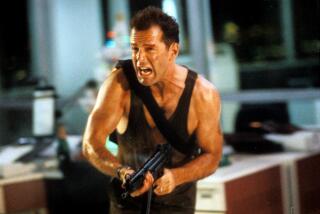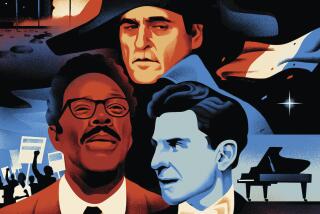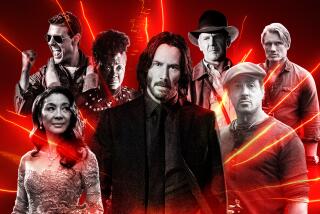Why the Duke Is Still King of Viewer Surveys
- Share via
Every year, surveys ask Americans to name their favorite movie stars. Recent results have varied, with the fluctuations of a fickle public’s opinion washing stars like Kevin Costner and Sylvester Stallone on and off the list like tides on the shore. But one name on the list has remained constant--the man at the top.
For years, the same actor was either first or second in popularity, which is curious considering he had to overcome one obstacle the other stars on the list have not. He’s dead.
Today marks the 20th anniversary of the passing of John Wayne, but the handicap of mortality has not slowed Wayne’s popularity any. Each passing year underscores the fact that Wayne’s enduring appeal is fundamentally different from any other movie star living or dead. In the scope of time, Wayne can be lumped together with other great stars of an older era: Cary Grant, Jimmy Stewart, Henry Fonda, Humphrey Bogart and Clark Gable. But that raises the question, why of all our pantheon of beloved stars, only Wayne still makes the list today.
Why is it that you will see a “God Bless John Wayne” bumper sticker, but the idea of replacing the name in that phrase with, say, Clark Gable or Spencer Tracy is ridiculous? What is it about Wayne that continues to resonate among a public generations removed from most of his films?
The key lies in the heroic aspects of his on-screen and off-screen personas that fused the actor and the man into one larger-than-life creation. This resulted in his total identification as the definitive American male. At the time of his death, President Jimmy Carter said, “He was bigger than life. In an age of few heroes, he was the genuine article. . . . He was a symbol of so many of the qualities that made America great. The ruggedness, the tough independence, the sense of personal courage reflected the best of our national character.”
Drew Casper, a professor of critical studies at USC’s film school, says that Wayne’s popularity stems from a moral strength lacking from films and our real-life leaders today. Casper, who runs classic Wayne films such as “Red River,” “The Quiet Man” and “The Searchers” for his classes, notes that “students still applaud at the end of ‘The Searchers’ when John Wayne returns Natalie Wood to her home and wanders back off into the desert.”
During his half-century career, Wayne played a variety of characters but always managed to give them a similar code of ethics, which he enforced with physical strength and a fierce will. “Stewart and Fonda had the moral code, but they were everyman. John Wayne was the leader of men,” Casper says.
“And with actors like Stewart and Fonda, there is a diffusion to their screen persona because of the greater range of characters they played. When you talk about Jimmy Stewart, you have to ask which Jimmy Stewart are you talking about: the idealistic young man of the Capra films, the hard-bitten Westerner in Anthony Mann films or the troubled everyman of the Hitchcock films.”
But essentially there was only one John Wayne. Notes Casper: “Wayne touched on the needs and aspirations of the post-World War II male and managed to synthesize them with his off-screen persona.”
Wayne’s Characters Were Men of Action
Wayne got his big break in the classic western “Stagecoach” in 1939, but it wasn’t until 1948 when director Howard Hawks cast him as the aging, driven cattle boss Tom Dunson in “Red River” that Wayne became a superstar.
Casper says that another important aspect of Wayne’s appeal--and what set him apart from other stars--was his directness as a man of action. “With Wayne, unlike Stewart or Fonda, there was no hemming and hawing. He saw what needed to be done and while others anguished over what to do, Wayne did it.”
A good example of this is the scene leading up to the final showdown in “Red River.” Dunson’s surrogate son Matt Garth (Montgomery Clift) has taken the cattle herd away from Dunson during the difficult drive. Dunson has vowed to kill Matt for the transgression, and when Dunson finally catches up to Matt, he strides through the herd of cattle straight for him, taking a bullet from John Ireland as he walks. Gerald Mast in his book “Howard Hawks, Storyteller” wrote: “It may seem like a hyperbolic claim, but no star in the history of film other than John Wayne could play the role in ‘Red River’ and make it mean what it does. Think of Gary Cooper marching toward Monty Clift at this climactic moment (too soft and loose). Or James Stewart (too calmly reasonable). Or Henry Fonda (too sweetly mysterious). None of these stars can ever walk the way Wayne does, devouring space with his stride.”
Wayne’s other great roles that solidified his role as icon of the American man of action included Sgt. Stryker in “Sands of Iwo Jima” (1949) and a vengeful ex-Confederate soldier in John Ford’s “The Searchers” (1956). “True Grit” (1969), for which he won an Oscar, ushered in the last period of his stardom as a surviving anachronism maintaining the old order in the face of a new era. Wayne managed to continue credibly playing that role through to his last film, “The Shootist” (1976).
Wayne was the No. 1 box-office star of the 1950s, and amazingly, despite the social upheavals of the era, retained that title through the ‘60s. It seems there was something comforting to the American public in Wayne’s stability and refusal to change despite all the turmoil around him.
“At the time of the counterculture revolution in the late ‘60s, Wayne was an antidote to the drastic social and cultural changes that were taking place, and he still fulfills that need for constancy in a chaotic world,” Casper notes.
As a Generation X-er who was only 9 when Wayne passed away (and who has never even seen a John Wayne film in a theater), the movie that first made an impression on me was his best film of the ‘70s, “Big Jake.” Upon reflection, it seems to represent the Duke at his best and most typical.
‘Big Jake’ Showed Wayne at His Best
A western, “Big Jake” tells the story of Wayne’s hunt to recover the kidnapped grandson he has never seen. The first time we see him, his estranged wife, played by Maureen O’Hara, brushes off the help of both the U.S. Army and the Texas Rangers. “This is going to be an extremely harsh and unpleasant kind of business, and will, I think, require an extremely harsh and unpleasant kind of man to see to it,” she says.
Cut to an extreme close-up of Wayne as Big Jake McCandles looking down the barrel of his rifle on a hanging about to take place below him. Three cowboys have a defenseless Scottish sheepherder mounted on a horse with a rope around his neck and are beating his young son. Jake rides down to them and by the mere mentioning of his name scares the cowboys into turning the sheepherder loose.
“I’m sorry, Mr. McCandles. I thought you were dead,” one of the cowboys says. “Not hardly,” Jake answers.
The sequence typifies everything that’s so riveting about Wayne. The strength and skill he possessed, the hardness of character he was known for, and most importantly, the willingness to risk his own life to aid the weak and outnumbered. So many times in so many films, Wayne was, both literally and metaphorically, the cavalry coming to the rescue.
No matter how much the country changes, no matter how our leaders may behave, we will always have the need to believe in a hero. That’s what makes John Wayne such an enduring star. People may wonder how so many years on, Wayne can still be America’s favorite movie star. After all, he’s dead, isn’t he?
Not hardly.
More to Read
Only good movies
Get the Indie Focus newsletter, Mark Olsen's weekly guide to the world of cinema.
You may occasionally receive promotional content from the Los Angeles Times.










